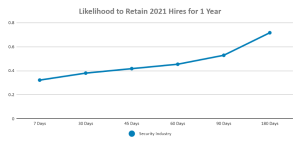BEYOND THE BOTTOM LINE: WHY CONTRACT-LEVEL COSTING CHANGES EVERYTHING
Gail Tutt, TEAM Software by WorkWave, CALSAGA Network Partner
Running a security company means managing dozens of moving parts—schedules, equipment costs, insurance premiums and client demands. There’s so much to stay busy with, so it may seem like tracking overall profitability is good enough. Revenue minus expenses equals success, right?
This approach works until it doesn’t. When margins start tightening or unexpected costs hit specific contracts, company-wide profitability becomes a rearview mirror—it shows you what happened, not what’s happening right now.
Beyond the Big Picture
Advanced job costing changes the conversation entirely. Instead of wondering why last quarter’s numbers looked different, you can drill down to see which contracts are performing and which ones need attention. This granular visibility matters because the instinct to cut costs across the board often hurts profitable work while leaving problem contracts untouched.
Consider two similar contracts on your books. Both involve the same type of security work, similar hourly rates and comparable client requirements. On paper, they look identical. But job costing might reveal that one generates healthy margins due to efficient scheduling and minimal overtime, while the other loses money every month because of excessive non-billable overtime or poor shift planning.
Without job-level data, both contracts disappear into your overall numbers. With it, you can address the specific issues dragging down performance while protecting what’s working well.
Look at It From the Standpoint of Securing New Contracts
Contract bidding requires balancing competitiveness with profitability. Labor costs vary by location and assignment type. Insurance requirements differ based on client risk profiles. Equipment needs change depending on site specifications. When you’re preparing a proposal, these variables can make or break your margins.
Security companies that understand their actual costs for similar work can price more accurately. They can be aggressive on contracts that match their operational strengths while avoiding deals that would strain resources.
This precision matters in California’s competitive market, where a few percentage points can determine whether you win profitable work or get locked into break-even contracts. Accurate cost data helps inform better bidding decisions.
Adding new contracts typically means adding complexity, but the relationship isn’t predictable. Advanced job costing systems can help companies scale efficiently because they provide real-time visibility into exactly where operational efficiency comes from and where resources are being consumed.
When your costing system tracks not just direct labor but also supervisory time, equipment depreciation, fuel costs by route, administrative overhead allocation and even indirect costs like training and uniforms, patterns emerge that aren’t obvious from financial statements. Some contract types require minimal oversight and generate consistent margins. Others consume disproportionate administrative time and management attention.
The Difference Becomes Even More Pronounced When You Consider Data Accuracy
Manual data entry creates opportunities for errors and delays that undermine job costing precision.
- Electronic timekeeping systems that feed directly into cost calculations eliminate manual timesheet transcription while ensuring accurate labor cost allocation
- GPS tracking automatically allocates vehicle costs and fuel expenses to specific jobs
- Inventory management systems track material usage by contract, providing precise cost allocation for supplies and equipment
This level of operational intelligence allows you to be selective about growth opportunities, focusing on work that fits your cost structure and operational strengths. More data flowing through the system means deeper insights and increased efficiency across your entire operation.
Integration across financial systems creates additional advantages.
- When job costing connects seamlessly with general ledger, accounts payable and accounts receivable systems, you maintain a single source of truth for all financial data
- Automated general ledger coding reduces manual classification work, while complete transaction histories support both internal controls and external auditing requirements
- This integration also streamlines month-end processes, reducing the time required for closing and financial statement preparation
Job costing provides visibility that enables proactive management rather than reactive problem-solving. When you can see exactly what each contract costs, you can spot trends before they become problems. You can identify opportunities to improve efficiency on existing work. You can make strategic decisions about pricing, staffing and growth based on real data rather than assumptions.
Success in this business comes down to making good decisions with good information. Job costing gives you that information, one contract at a time.
 Prior to joining TEAM in 2021, Gail spent 35 years in the private sector as a senior level finance and operations manager across multiple industries. Most recently, she served as CFO of a regional security company in San Jose, California. As an end-user of WinTeam for 12 years, Gail’s able to provide invaluable insight and expertise in her role as Business Consultant. Her hobbies include breeding and showing standard wirehair dachshunds, hiking and spending time with her family.
Prior to joining TEAM in 2021, Gail spent 35 years in the private sector as a senior level finance and operations manager across multiple industries. Most recently, she served as CFO of a regional security company in San Jose, California. As an end-user of WinTeam for 12 years, Gail’s able to provide invaluable insight and expertise in her role as Business Consultant. Her hobbies include breeding and showing standard wirehair dachshunds, hiking and spending time with her family.








 Trackforce Valiant + TrackTik combines over 45 years of total experience with the brightest and most influential minds to provide its customers with the industry’s most comprehensive security workforce management solution. Our cloud-based solutions help corporations and security guard service providers handle every aspect of security workforce management.
Trackforce Valiant + TrackTik combines over 45 years of total experience with the brightest and most influential minds to provide its customers with the industry’s most comprehensive security workforce management solution. Our cloud-based solutions help corporations and security guard service providers handle every aspect of security workforce management. Maddie started her career in the global banking industry as an Applications Programmer prior to joining TEAM Software by WorkWave. After working as a Quality Analyst, Maddie transitioned to Product Owner, where she combines her passion for problem solving with the guidance of product strategy to bring forward enhancements that add value to users while driving future innovations.
Maddie started her career in the global banking industry as an Applications Programmer prior to joining TEAM Software by WorkWave. After working as a Quality Analyst, Maddie transitioned to Product Owner, where she combines her passion for problem solving with the guidance of product strategy to bring forward enhancements that add value to users while driving future innovations.
 Andrea has over 15 years of software-as-a-service (SaaS) marketing experience. In her role as Marketing Director at TEAM Software by WorkWave, she drives the company’s strategic marketing direction globally. She is a graduate of the University of Nebraska-Lincoln, where she earned her Bachelor’s degree in Journalism.
Andrea has over 15 years of software-as-a-service (SaaS) marketing experience. In her role as Marketing Director at TEAM Software by WorkWave, she drives the company’s strategic marketing direction globally. She is a graduate of the University of Nebraska-Lincoln, where she earned her Bachelor’s degree in Journalism.